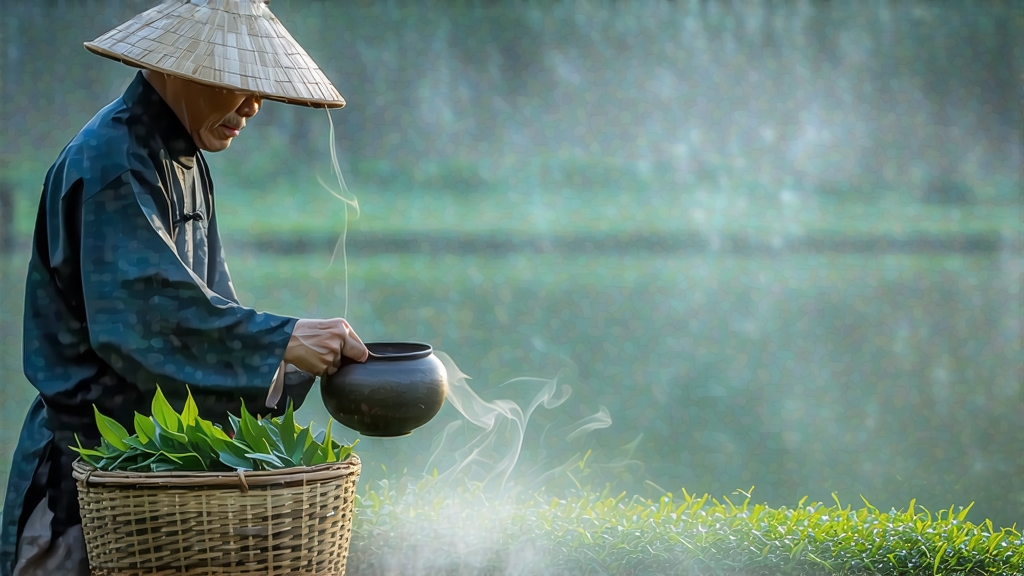
Longjing, literally “Dragon-Well,” is the most celebrated among China’s more than one thousand green-tea varieties. To the Chinese palate it is the benchmark against which all other greens are judged; to the outside world it is often the first name that comes to mind when “Chinese green tea” is mentioned. Yet behind the familiar jade-green leaves and sweet, nutty aroma lies a microcosm of Chinese history, geology, and craftsmanship that remains largely untold in languages other than Chinese. This essay invites the international reader to step beyond the souvenir tin and discover why a single cup of authentic West Lake Longjing can taste like liquid springtime.
-
Historical echoes
The earliest written record dates to the Tang dynasty (618-907), when the monk-poet Lu Yu listed “Longjing spring” among the waters suitable for brewing tea in his Classic of Tea. By the Song era (960-1279) the leaves themselves were tribute, carried by canal to the imperial court at Hangzhou, a city that later became the Southern Song capital. Legend credits the Qianlong Emperor (r. 1735-96) with elevating Longjing to mythic status: during a southern inspection tour he supposedly pocketed freshly plucked shoots in his sleeve, returned to Beijing, and released them into the palace well, where they danced like dragons—hence the name. Apocryphal or not, the story cemented an association between Dragon-Well and imperial favor that persists in Chinese marketing copy to this day. -
Terroir: one lake, five peaks, countless micro-gardens
Authentic West Lake Longjing (Xihu Longjing) is grown inside a 168 km² UNESCO buffer zone surrounding Hangzhou’s West Lake. Within this small area, five sub-districts—Shífēng (Lion Peak), Méijiāwǔ, Wēngjiāshān, Hǔpáo (Running Tiger), and Lóngjǐng village itself—offer subtly different flavor signatures. Shífēng yields the most sought-after profile: bright, orchid-sweet, with a lingering “bean” note reminiscent of fresh fava. The soil is quartz-sandy, derived from weathered limestone; the lake moderates temperature, creating morning mist that filters sunlight and concentrates amino acids—especially L-theanine—in the buds. Elevations of 150–300 m are high enough for cool nights yet low enough to escape frost, giving the bushes a six-week picking window that begins around Qingming (early April) and ends before Guyu (late April). Leaves harvested after this period are still sold as “Longjing,” but connoisseurs prefix them with “pre-” or “post-Qingming,” the difference in price often exceeding 500 %. -
Cultivars: beyond the ubiquitous #43
International buyers usually meet Longjing #43, a clonal cultivar released in 1972 that buds early, yields uniformly flat leaves, and tolerates mechanized harvesting. Purists, however, prize the old-tree “Qunti” (population) cultivar—seed-propagated bushes 40–80 years old whose deeper roots absorb more minerals, translating into layered texture and a quartz-mineral finish. A third cultivar, Zhongcha 108, is gaining traction for its resistance to anthracnose and lower caffeine, appealing to health-oriented markets. Each cultivar responds differently to pan-firing temperature, so master tea makers adjust their wrist angles and dwell times almost leaf by leaf. -
Craft: the ten hand-motions that freeze an instant
Within minutes of plucking, the tender one-bud-one-leaf sets are spread 3 cm thick on bamboo trays to lose surface water. Once the edges feel parchment-dry to the touch—usually 2–3 hours in moderate breeze—the leaves are ready for qingguo, the emblematic pan-firing step. A seasoned master works on a cast-iron wok preheated to 80 °C, brushing it with a tuft of fresh tea oil to season the surface. Ten distinct motions—cui (push), dà (tap), dàng (shake), tuō (lift), kāi (spread), yǎo (press), mó (grind), tuī (slide), kòu (lock), and tiào (flip)—are executed in cycles lasting 12–15 minutes. The goal is dual: enzymatic